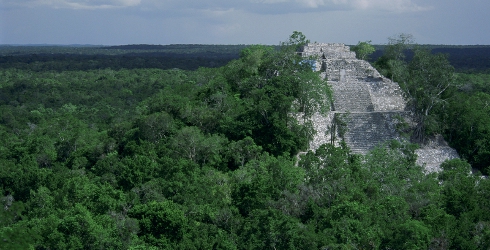Calakmul Biosphere Reserve, the largest tropical forest reserve in Mexico, is a treasure trove of Mayan history in the heart of the Maya Forest. The ruins in the middle of Calakmul reserve’s 1.8 million acres of forests extend over 10 square miles – the remains of a city that was the powerbase of Tikal’s rival dating back to AD 364.
Calakmul in Maya means “the city of two adjacent pyramids.” And the spectacular view of the surrounding jungle from the top of one of these massive pyramids extends into Guatemala and includes several archaeologically important ruins from the Mayan era.
The Maya Forest, covers almost 15 percent of Campeche state in Mexico, and extends into Guatemala and Belize. The Calakmul reserve, slightly larger than Delaware, harbors jaguars, crocodiles, Baird’s tapir, and more than 230 bird species.
CALAKMUL-SIAN KA’AN CORRIDOR
The Conservancy began working in a new site in 2007: the Calakmul Sian Ka’an Corridor. This vast forested area links two biosphere reserves and is important for far-ranging animals such asjaguars and migratory birds.
Here as in the community owned lands in Calakmul, the Conservancy recognizes that effective conservation can only be achieved if the needs and aspirations of local people are met. In this site, we are working with a new partner organization — the Organization of Forestry Ejidos of the Maya Zone (OEPF). Our shared goal is to conserve the forest while improving the income realized from forest activities.
Tapping chicle (a resin from the chico zapote tree native to Central America) and timber extraction have provided the economic rationale for conserving the community-owned forests. Although chicleros continue to tap these trees, there are fewer tappers than in the past. In 2008 the Conservancy funded a workshop bringing together chicle tappers from several communities to share best practices on improving production and marketing possibilities.
In 2007 Hurricane Dean hit the region hard. Some of the communities reported withstanding the hurricanes better than in previous years thanks to the forest buffer. The Conservancy began working with ejidos affected by the hurricane to find uses of and ways to market their fallen timber and begin restoration efforts.
Source: www.nature.org


